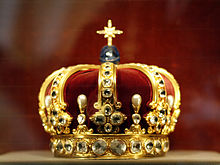Crown of Wilhelm II.
The crown of William II. , Also crown William I is called, was the first in the late phase of the history of the Kingdom of Prussia made and one of the Prussian crown jewels .
description
It is a bow- shaped crown made of pure gold , decorated with diamonds , pearls and sapphires . The golden crown ring has engraved edges and bears 24 large diamond roses, which are set in leaf-like ornament. Eight large and eight small prongs rise above the hoop. The small prongs are wide and curved like a volute on both sides. They have a heart-shaped diamond at the top, above a large pear pearl, which is set in a kind of gold bud. The large prongs are also curved volute-like on the hoop and merge into vine leaves upwards. These have two large leaves that go to the side and one smaller leaf that faces up. The lateral leaves have large diamond roses, the upper leaf and the petiole smaller ones. From these prongs arise the eight brackets, which swing upwards in an arc and converge horizontally at the top. Each bracket is decorated with eight or ten large diamonds. On the top sits the globe, a large egg-shaped sapphire with a diamond-set cross . The inside of the crown is lined with red velvet. A total of 142 rose- cut diamonds , 18 brilliant-cut diamonds , eight thick stones and two sapphires as well as eight pearls are used in the crown.
history
The Prussian cabinet ordered the production of the crown on February 27, 1889. Emil Doepler d. J. designed a model that was executed by the court jeweler Hugo Schaper. The diameter of the crown is 21 cm, its height 20 cm.
It was not worn during any coronation, but only had a representative purpose. Today it is located at Hohenzollern Castle . According to the Royal Magazine, after World War II, in the post-war period, most of the jewels attached to the crown were sold by the Hohenzollerns and replaced with rhinestones .
See also
literature
- Heinz Biehn : The crowns of Europe and their fate . Limes Verlag, Wiesbaden 1957.
